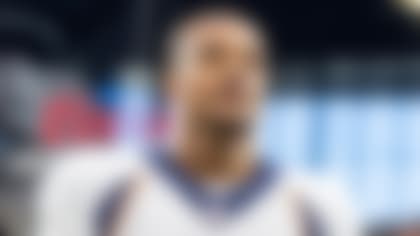A year ago, the Miami Dolphins changed the strategic landscape of the NFL when they traveled to Foxborough, Mass., and unleashed their Wildcat offense on the unsuspecting New England Patriots.
As Pats nose tackle Vince Wilfork told reporters in New England this week, "It was shocking because we really didn't know what they were doing and things they were doing. We tried to make adjustments, but it didn't happen."
What did happen was that the Dolphins, with running back Ronnie Brown taking direct snaps from the Wildcat formation, generated 119 yards and five touchdowns on the way to a 38-13 victory. Since then, the Patriots and other Dolphins opponents did successfully adjust, and the Wildcat, especially in recent instances, has looked more like a docile kitty.
In the past two weeks -- a loss to the New Orleans Saints and a win over the New York Jets -- it was a virtual non-factor. Against the Saints, the Dolphins ran 14 plays from the formation for 30 yards and two short touchdowns. Against the Jets, they used it only seven times for a net of 6 yards (with Brown's 13-yard run the only time it gained more than a yard).
Since that first Miami-New England game in '08, other teams have taken occasional stabs at the Wildcat -- though not to the degree that the Dolphins have -- and their results have been underwhelming. That, plus the decline in the use and productivity of Miami's Wildcat, has raised questions about whether the scheme is beginning to fade because it is less effective. Although the Dolphins acknowledge their last two opponents did a good job of defending it, neither their coaches nor players has given any indication that the Wildcat is being shelved any time soon.
The Dolphins' opposition doesn't expect that, either. In fact, the Patriots fully anticipate seeing the Wildcat when the Dolphins visit Foxborough on Sunday.
"I'm pretty sure there's going to be some different version we haven't seen to it," Wilfork said. "But they do what they do. They want to run the football, so that's a challenge for us up front."
And that is the primary goal of the formation: To enhance the chances for successful running plays. By moving the quarterback out wide, and forcing a defender to account for him, the Wildcat creates a mathematical mismatch that theoretically gives the offense more blockers than the defense has tacklers.
"When we face a traditional offense, you don't account for the quarterback (as a ball-carrier)," said Atlanta Falcons coach Mike Smith, whose team opened the season with a 19-7 win against the Dolphins, a game in which Miami ran just three plays out of the Wildcat for 4 yards. "Basically, in the majority of schemes, you want the quarterback running the football because you get an opportunity to hit him. Basically, you're accounting for him as someone to hand the ball off to someone else. That's why when people play against the run with an eight-man front you have an extra defender that's unblocked. Now (with the Wildcat), they're giving the snap to someone who can distribute the ball with a handoff but also can run the ball, so you get a disadvantage on defense in terms of the numbers.
"I think it's a great strategy. I don't believe it's a fad. It obviously can be a segment of different clubs' offenses."
Still, the defensive coaches for the Saints and Jets have been praised for finding ways to help minimize the Wildcat's impact the past two weeks. After the Dolphins had some early success this season with the formation, Saints defensive coordinator Gregg Williams began blitzing his cornerbacks off the edge each time Brown was in the shotgun formation. The result was multiple runs that lost yardage.
On Oct. 12, in a 31-27 triumph over the Jets, the Dolphins rushed for 151 yards, 86 coming from the Wildcat. Last Sunday, the Dolphins failed to make a dent with the formation, in part because the Jets tweaked some of what they had done in the earlier meeting and in part because their defenders executed better than they did in the previous game.
"How we played it the second time was very similar to how we played it the first time," Jets defensive coordinator Mike Pettine said. "We just widened the guys on our edges and brought (safety) Jim Leonhard down a little bit closer to the box. But the brilliance of the offense is it forces you to make a one-on-one tackle a lot of times against a damn good running back, whether that's Ricky Williams or Ronnie Brown. We missed some tackles in the first game. We didn't play well. It was just a lackluster performance by our defense."
In fact, as Pettine points out, the Dolphins' lone big Wildcat run last Sunday -- a 13-yard gain by Brown in the first series of the fourth quarter-- resulted from linebacker David Harris missing a chance to tackle him near the line of scrimmage.
Such errors, though, can happen given the speed advantage that comes with direct-snap runs.
"Everything happens a split-second faster than it would if it was a normal quarterback-running back exchange," Saints cornerback Jabari Greer said. "Since the quarterback in the Wildcat has the option to run, that makes the challenge even greater. It speeds up the process a fraction of a second, and in this game, that matters."
The Wildcat does limit offensive options because it so far has not proven to be an effective passing scheme. The Dolphins have tried using a true quarterback, rookie backup Pat White, behind center, but he has shown he is not developed enough to make a meaningful impact and his role remains a work in progress.
Other teams haven't found much success using true quarterbacks in the Wildcat, either. The Philadelphia Eagles, for instance, have steadily gotten away from inserting reserve quarterback Michael Vick for Wildcat plays because, even though he is known for his dynamic running skills, he so far hasn't shown he can run better or even as well as a true running back.
Nevertheless, the primary reason that Pettine and other coaches throughout the NFL don't see the Wildcat going away in the foreseeable future is because it forces defenses to spend substantial time preparing for it regardless of how much it is used, if it all.
"Sure, teams might be catching up to it, but at what price?" Pettine said. "How much of their game-plan meeting did they have to devote to it? How much of their practice time did they have to devote to it where they normally would have been working on other things they now won't be able to run in the game? You have to allocate a disproportionate amount of time to prepare for it than what you might end up actually using, but if you're not prepared for it, then a team's going to go ahead and continue to run it until you stop it."
According to Smith, a former defensive coordinator for the Jacksonville Jaguars, the Falcons spent large chunks of their offseason and preseason working on how to defend the Dolphins' Wildcat. Because of Wildcat preparation, he said, less time was spent on installing the defensive scheme that Atlanta would be using 95 percent of the time.
"And during the week, we will always run a couple of plays and will always walk through (the Wildcat defense) just to keep it fresh in our minds," Smith said. "I think offensive coordinators try to drive defensive coordinators crazy. You know it's a copycat league, and I think they get together in the offseason and say, 'All right, we're going to make these defensive guys' lives miserable. And we're only going to do it this percentage of time, but they're going to have to waste all that time getting prepared for it.'"
Somewhere, you know Dolphins coach Tony Sparano is smiling over that one.




